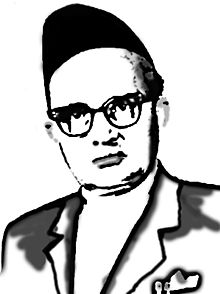Bhim Nidhi Tiwari
Not be confused with the Nepalese Communist leader of the 1980s, Bhim Nidhi Tiwari.[1]
Bhim Nidhi Tiwari भीमनिधि तिवारी | |
|---|---|
 | |
| Born | 1911 |
| Died | 1973 (aged 61–62) |
| Nationality | Nepalese |
| Occupation(s) | Poet, Novelist, playwright |
| Spouse | Bhuwaneshwori Tiwari |
| Children | Benju Sharma, Manju Kanchuli Tiwari, Niranjan Tiwari, Nikunja Tiwari |
| Parents |
|
Bhim Nidhi Tiwari(Nepali: भीमनिधि तिवारी) (1911–1973)[2] was a leading[3][4] Nepali poet, novelist and playwright.[5][6][7] He was a well-known poet of the post-1950s era[8][9] and was a firm believer in social reforms and wrote against smoking, drinking, and gambling. He published over 38 works in various styles.
Life
He was born in Dillibazar,
In 1966, he represented Nepal as Ministry of Education in the East Asia
In 1959, he chronicled in a film with his namesake.[12] In the late 1960s, he was a member the Regmi Research Project's Board of Directors.[13][14]
Works
Tiwari wrote short stories, novels, poems, lyrics, and satires which provide insight into Nepalese lifestyles, culture, mythologies, and history. He was also the recipient of many awards and prizes. He received the Madan Puraskar[15] in 1960 as well as the "Prakhyan Trishakti Patta", "Rajyabisekh Padak", and "Gyanpad Sewa". The historical dramas "Silanyas", "Matokomaya" and "Yasashvisav" also received awards.
In one of his best-known poems titled "Dagbatti", he tells about his experience as a child of seven years when his mother died and in the night he was taken to the ghats burning grounds (cremation fields), his head was shaved and what feelings engulfed him when fire consumed his mother's body. Other works included Samajik kahani,[16] Bisphot (also spelled Visphot and it was about "social injustice and social disintegration"),[17] Putali, Tarpan, Adarsha Jeevan, Bibaha, Barshiksa, Sahanshila Shushila, Yashawi Shava, and Yashash.[18]
He and his works were also chronicled in the 2013 book Selected poems of Bhim Nidhi Tiwari by Rabhindra Nath Rimal that was published by Nepal Academy.[19]
References
- ^ Nepal Press Digest, Volume 29, Issues 1-511985, page 345, 1980s, Regmi Research Project
- ISBN 9993317020
- ^ Contributions to Nepaless Studies, Volume 19, page 16, 1992, Institute of Nepal and Asian Studies, Tribhuvan University
- ISBN 0824825128
- ^ The Nepaless Perspective, page 476, 1969, Gorkhapatra Corporation
- ^ Nepal: A Conspectus, page 107, 1977
- ^ Nepal: a profile, page 96-99, 1970, Nepal Council of Applied Economic Research
- ^ Nepal Almanac: A Book of Facts, page 470-472, 1983
- ^ Shresta, Chandra Bahadur, Katmandu Guide, page 33, 1956,
- ^ Records of the General Assembly, Volume 2, page 134, 1966
- ^ Copyright, Volumes 3-4, page 49, 1967, World Intellectual Property Organization
- ^ Nepal Who's who, page 211-463, 1997, Research Centre for Communication and Development
- ^ Regmi Research Project, Issues 300-399, page 256, 1968, Regmi Research Project
- ^ Nepal Press Project, Issues 200-299, 1972, Regmi Research Project
- ^ "Khushi bags Madan Puraskar". nepalitimes.com. September 11, 2015. Retrieved September 12, 2015.
- Calcutta University
- ^ Modern Nepali Poems, 1972, Nepal Academy
- ^ Raman Acharya, Madhu, Nepal concise encyclopedia: a comprehensive dictionary of facts and knowledge about the kingdom of Nepal, page 19-184, 1986
- ^ Selected Poems of Bhim Nidhi Rimal, nla.gov.au
